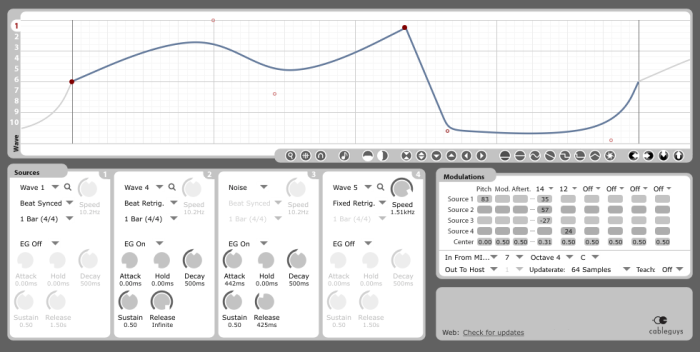One of my favorite things about Curve is the combination of its flexible modulation engine and the waveform drawing tools.
Now wouldn’t it be nice to have the same powerful tools to draw custom waveforms for LFOs and envelopes to drive other audio sources? Welcome to MidiShaper!
Four LFOs and four envelope generators work together in a sophisticated modulations matrix that can be set up to output modulated pitch, modwheel, channel aftertouch or any MIDI control messages.
MidiShaper’s LFOs can run infinitely or be retriggered, synced to your host sequencer from a buzzy 1/128 to an expansive 32 bars, set to the played note, or run from 0.02 Hz up to the audible range and brain frequency. Like Curve, MidiShaper features completely editable waveforms for its LFOs.
MidiShaper is set up by routing the MIDI output to your host software, or anything else that handles MIDI automation, both software and hardware.
Although many hosts and plugins already have LFOs and envelopes, the ones in MidiShaper are more advanced than most. Each of the 4 LFOs takes its source from a selection of 10 custom drawable waveforms + noise. They can run free or beat synced – including retrigger and one-shot modes for both. The LFO rate goes from a blazing fast 1/128 to a slow as molasses 32 bar speed. Dedicated envelope generators are available for each individual LFO. These envelopes can be used on the LFO to fade it in/out, or simply to modulate a parameter in the matrix when no LFO is running on that particular source.
The modulation matrix features pitch, modwheel and aftertouch, as well as 6 assignable MIDI CC slots. The handy “Teach MIDI CC” effortlessly links the desired control/parameter to the MIDI CC number of your choice. Center parameters set the value from where the modulation takes place.
MidiShaper’s waveform screen comes with buttons for speeding up the creation of your waveforms. You get some basic waveform shapes, a randomizer, zoom, grid and note display, and various tools to move the waveform and its points.
Cableguys did some nice videos showcasing MidiShaper’s features and explaining how to use it in Ableton, Cubase, and Logic. I did not find any details on how to set it up in my host of choice – FL Studio, so I made a little video where I use MidiShaper to modulate the filter cutoff on u-he’s most excellent Diva software synthesizer.
So what do I think?
Format: effect plug-in for PC and Mac (VST/AU)
Price: 20 EUR / $30 USD incl. VAT
Like: Flexible, feature-full, fun
Don’t like: —
Verdict: 9/10
To be honest, MidiShaper is probably not an essential plug-in for many of you. Generally, synth and effect parameters can be automated within your host software, and LFOs and envelopes are included in many plugins already.
In fact, automation clips in FL Studio are so flexible and easy to set up I really don’t need MidiShaper for basic things. But, I know not all hosts have this down. And for creating more advanced effects, the waveform drawing features in MidiShaper are hard to beat. Much like all other Cableguys plugins I have used MidiShaper is easy to use, intuitive, and extremely flexible.
If you ever find yourself in need of modulating synths or effects that lack an LFO and you don’t want to spend a lot of time automating things in your host, then MidiShaper is for you. Likewise, adventurous musicians and sound designers who require more than a simple sine/triangle/square/saw LFO waveform should also consider this plugin. A free fully functional demo version is available from Cableguys, so check it out.
More information: Cableguys



